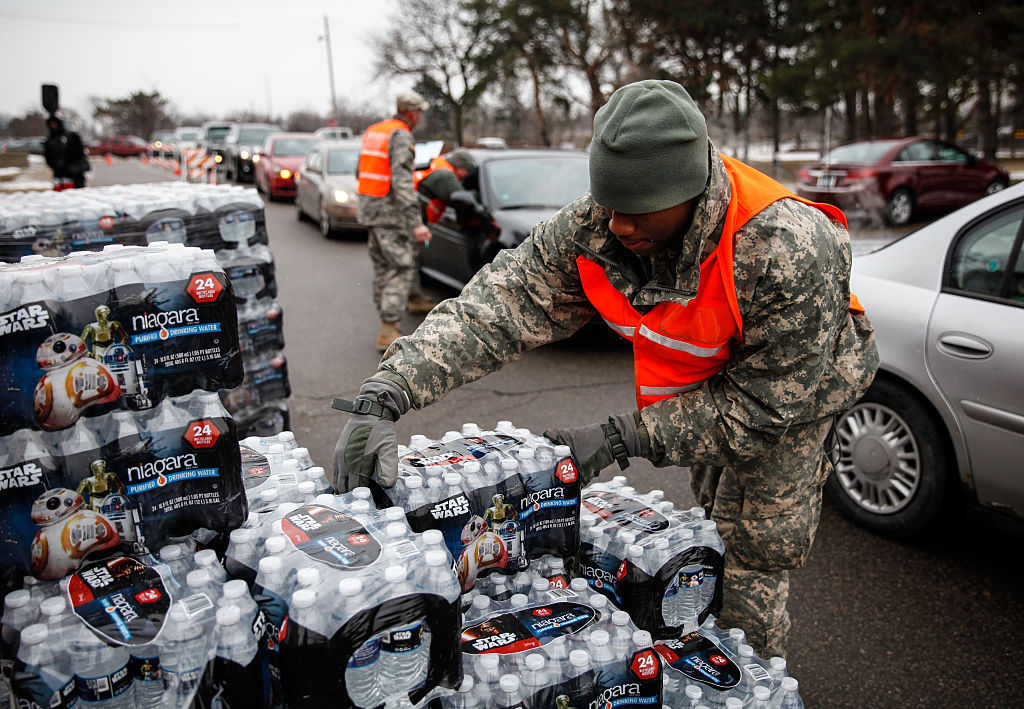
Source: Sarah Rice / Getty
In the United States, environmental crises are not just isolated incidents but stark reminders of systemic issues that disproportionately affect marginalized communities. From contaminated water to toxic air pollution, these crises unveil the harsh realities faced by residents in various parts of the country.
MORE: Environmental Racism: How Racist Policies Around Climate Affect Black People
The water crisis in Flint, Michigan, represents a poignant environmental tragedy that had a profound impact on Black residents living in the state. Many view it as a stark illustration of environmental racism.
In 2014, Flint, Michigan, made headlines across the nation due to the discovery of lead contamination in its drinking water. This contamination stemmed from the decision to transition the city’s water source from Lake Huron to the Flint River, which contained elevated levels of lead and other harmful substances. The repercussions of this crisis have been deeply felt by the residents of Flint, especially children, who are particularly susceptible to the adverse effects of lead exposure on their health and overall well-being. Twelve people reportedly died after consuming the untreated water. Governor Rick Snyder was in office when the health crisis struck the majority Black city.
According to Click On Detroit Local 4 News, in 2020, residents of Flint affected by the lead-contaminated water reached a settlement exceeding $600 million in negotiations between Michigan officials and residents. However, despite the agreement, residents are still awaiting their settlement payments, highlighting the ongoing need for further efforts to establish trust within the community.
In February, a small portion of Flint residents were delivered a win when several property owners, businesses, and adults finalized a settlement totaling $25 million with Veolia North America (VNA), an engineering firm partially responsible for the crisis.
The class action lawsuit, initiated in 2016 on behalf of more than 90,000 residents, targeted VNA and other defendants. Certification against VNA and a second private water engineering company, Lockwood, Andrews & Newnam (LAN), was officially granted in August 2021. LAN had previously reached a settlement with residents in October of the same year.
According to the University of California, substantial investments have been directed towards various upgrades to the Flint water system, including a $5 million allocation for a chemical feed building tasked with monitoring and treating the water supply,
Though construction has been gradual, Flint officials also made moves to improve the city’s water supply by replacing lead-infested pipes. Around $22 million has been earmarked for water main replacements, alongside an extra $11 million dedicated to installing new water meters. These significant expenditures reflect the ongoing efforts to rectify the aftermath of the Flint water crisis. It’s an ironic twist, considering the crisis originated from a cost-saving measure—a decision to switch the water supply made by an emergency manager.
Detroit has long struggled with air pollution due to industrial activities, transportation emissions and other factors. Poor air quality in the city has been linked to various health problems, including respiratory issues and cardiovascular diseases.
In the American Lung Association’s 2023 “State of the Air” report, Detroit was ranked as the 32nd most polluted city for ozone pollution, a slight improvement from its 24th ranking in the previous year’s report. However, Wayne County received an “F” grade for ozone pollution.
The report also highlighted short-term spikes in particle pollution, which pose significant health risks, including potential fatality. Unfortunately, Detroit saw an increase in short-term particle pollution compared to the previous report, resulting in more unhealthy days. The city ranked 35th worst for short-term particle pollution, with Wayne County also receiving an “F” grade in this category.
Regarding year-round particle pollution, the 2023 “State of the Air” report noted a slight deterioration in Detroit’s air quality compared to the previous year. The city was ranked as the 12th most polluted for year-round particle pollution, worse than its 12th ranking in the previous report.
“Here in Detroit and across the nation, we are seeing ozone pollution improving, thanks in big part to the success of the Clean Air Act. But there is more work to do,” Ken Fletcher, Advocacy Director for the Lung Association, shared in a statement. Fletcher urged for the Biden Administration to create policies that would help reduce pollution in Detroit.
“Even one poor air quality day is one too many for our residents at highest risk, such as children, older adults, individuals who are pregnant and those living with chronic disease. That’s why we are calling on lawmakers at the local, state and federal levels to take action to ensure that everyone has clean air to breathe.”
Cancer Alley, Louisiana
Cancer Alley refers to a stretch of land along the Mississippi River between Baton Rouge and New Orleans in Louisiana, known for its high concentration of industrial facilities, chemical plants and refineries. Residents in this area face increased health risks due to exposure to air and water pollution, leading to higher rates of cancer and other diseases.
According to the ProRepublica, over the last year, new petrochemical facilities threaten to cause more harm to residents living within the Mississippi River corridor. Contractors have been actively constructing amid growing concerns over the potential hazards associated with specific industrial plants. Notably, attention has been drawn to projects such as the proposed $9.4 billion plastics factory by Formosa in St. James Parish and the enduring Denka neoprene facility in St. John Parish. The latter has been flagged for its hazardous emissions, as underscored by an Environmental Protection Agency model that calculates cancer risk in the vicinity of chemical plants.
The Bronx Asthma Alley
This term refers to certain areas in the Bronx, New York, that experience high rates of asthma and other respiratory conditions. Poor air quality, exacerbated by factors such as traffic congestion, industrial activities, and inadequate access to healthcare, contributes to the prevalence of asthma in these communities.
Houston’s High Levels of Lead in Children
Houston, Texas, has faced concerns about high levels of lead exposure among children, primarily due to lead-based paint in older homes and other sources of lead contamination in the environment. Lead exposure can cause developmental delays and other health problems in children.
Pahokee, Florida, Sugar Cane
Pahokee, Florida, located near the southern shore of Lake Okeechobee, is home to sugar cane production. Concerns have been raised about environmental impacts related to sugar cane farming, including water pollution from agricultural runoff and pesticide use, which can affect local ecosystems and public health.
Uniontown, Alabama, Landfill
Uniontown, Alabama, a predominately Black area, has faced environmental justice issues related to the disposal of coal ash from a nearby power plant. According to Democracy Now, in Uniontown, Alabama, residents have been grappling with the presence of the Arrowhead landfill, an expansive site twice the size of New York’s Central Park. Residents have raised concerns about health risks associated with the landfill, including air and water pollution, as well as the broader environmental and social impacts on the community. Coal ash is laden with hazardous substances, including arsenic, mercury, and boron, known to adversely affect the nervous and reproductive systems, among other health concerns.
Residents’ protests primarily centered around the transportation and dumping of toxic coal ash, a byproduct of coal combustion, stemming from a major spill in Kingston, Tennessee — the largest of its kind in U.S. history — in the early 2000s. Uniontown received nearly 4 million tons of coal ash via rail, sourced from a predominantly white county in Tennessee.
Los Angeles, California, struggles with various sources of toxic pollution, including emissions from vehicles, industrial facilities and other sources. Poor air quality in the region contributes to health problems such as respiratory illnesses and cardiovascular diseases, particularly in communities near major highways and industrial zones.
In 2023, Los Angeles received an F grade in the American Lung Association’s “State of the Air” report, KTLA 5 reported. Refineries, ports for the major trucking routes and the entire transportation sector are to blame for the environmental issue.
Warren County, NC, Toxic Waste
In 1982, Warren County, North Carolina, became a focal point of the environmental justice movement when it was selected as the site for a hazardous waste landfill. The siting of the landfill in a predominantly African American community sparked protests and legal battles, highlighting concerns about environmental racism and the unequal distribution of environmental burdens.
SEE ALSO:
What Is Redlining And How Can It Be Solved?
Environmental Racism: Pollution From Canada Wildfires Exacerbates Existing Air Quality Inequities
The post 10 Modern-Day Examples Of Environmental Racism appeared first on NewsOne.
10 Modern-Day Examples Of Environmental Racism was originally published on newsone.com















